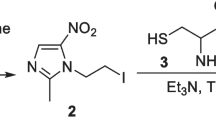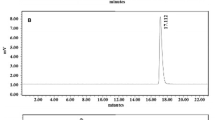Abstract
Tumor hypoxia can decrease the efficacy of clinical therapy due to resistance toward radiation damage and chemotherapy, thus detection of tumor hypoxia by radiolabeled hypoxia markers is important for the control of tumor. Radiopharmaceuticals with two bioreductive groups, such as propylene amine oxime-bisnitroimidazole or monoamine-monoamide dithiol (MAMA) -bisnitroimidazole, have potential to improve hypoxia selectivity. In order to obtain radiopharmaceuticals with better features, we synthesized two novel [99mTcN]2+ complexes with bisnitroimidazole moieties and MAMA ligand for targeting tumor hypoxia. Their physicochemical characters and biodistribution were also investigated. Both the [99mTcN]2+ complexes show good stability and hydrophilicity. They show faster clearance from blood and soft tissues, better tumor retention and favorable tumor-to-tissue ratios compared with a control complex without nitroimidazole group. In addition, both of them show more favorable biodistribution patterns than the corresponding [99mTcO]3+ complexes. These results indicate that the 99mTcN-labeled MAMA-bisnitroimidazole complexes would have potential to image tumor hypoxia in vivo.



Similar content being viewed by others
References
Semenza GL (2003) Angiogenesis ischemic and neoplastic disorders. Annu Rev Med 54:17–28
Vaupel P, Mayer A (2007) Hypoxia in cancer: significance and impact on clinical outcome. Cancer Metastasis Rev 26:225–239
Moeller BJ, Richardson RA, Dewhirst MW (2007) Hypoxia and radiotherapy: opportunities for improved outcomes in cancer treatment. Cancer Metastasis Rev 26:241–248
Subarsky P, Hill RP (2003) The hypoxic tumour microenvironment and metastatic progression. Clin Exp Metastasis 20:237–250
Vaupel P (2008) Hypoxia and aggressive tumor phenotype: implications for therapy and prognosis. Oncologist 13:21–26
Ballinger JR (2001) Imaging hypoxia in tumors. Semn Nucl Med 31:321–329
Mees G, Dierckx R, Vangestel C, Van de Wiele C (2009) Molecular imaging of hypoxia with radiolabelled agents. Eur J Nucl Med Mol Imaging 36:1674–1686
Hugonnet F, Fournier L, Medioni J, Smadja C, Hindié E, Huchet V, Itti E, Cuenod C-A, Chatellier G, Oudard S, Faraggi M (2011) Metastatic renal cell carcinoma: relationship between initial metastasis hypoxia, change after 1 month’s sunitinib, and therapeutic response: an 18F-fluoromisonidazole PET/CT study. J Nucl Med 52:1048–1055
Hoigebazar L, Jeong JM, Lee JY, Shetty D, Yang BY, Lee Y-S, Lee DS, Chung J-K, Lee MC (2012) Syntheses of 2-nitroimidazole derivatives conjugated with 1,4,7-triazacyclononane-N, N′-diacetic acid labeled with F-18 using an aluminum complex method for hypoxia imaging. J Med Chem 55:3155–3162
Mukai T, Suwada J, Sano K, Okada M, Yamamoto F, Maeda M (2009) Design of Ga-DOTA-based bifunctional radiopharmaceuticals: two functional moieties can be conjugated to radiogallium-DOTA without reducing the complex stability. Bioorg Med Chem 17:4285–4289
Mallia MB, Subramanian S, Banerjee S, Sarma HD, Venkatesh M (2006) Evaluation of 99mTc(CO)3 complex of 2-methyl-5-nitroimidazole as an agent for targeting tumor hypoxia. Bioorg Med Chem 14:7666–7670
Mallia MB, Subramanian S, Mathur A, Sarma HD, Venkatesh M, Banerjee S (2008) On the isolation and evaluation of a novel unsubstituted 5-nitroimidazole derivative as an agent to target tumor hypoxia. Bioorg Med Chem Lett 18:5233–5237
Mei L, Chu TW (2011) [99mTc(CO)3] + labeled histidine derivative containing 4-nitroimidazole:synthesis, biodistribution as a tumor hypoxia imaging agent. Nucl Sci Tech 22:105–110
Giglio J, Fernández S, Pietzsch H-J, Dematteis S, Moreno M, Pacheco JP, Cerecetto H, Rey A (2012) Synthesis, in vitro and in vivo characterization of novel 99mTc-‘4 + 1’-labeled 5-nitroimidazole derivatives as potential agents for imaging hypoxia. Nucl Med Bio 39:679–686
Giglio J, Fernández S, Rey A, Cerecetto H (2011) Synthesis and biological characterisation of novel dithiocarbamate containing 5-nitroimidazole 99mTc-complexes as potential agents for targeting hypoxia. Bioorg Med Chem Lett 21:394–397
Bonnitcha PD, Bayly SR, Theobald MBM, Betts HM, Lewis JS, Dilworth JR (2010) Nitroimidazole conjugates of bis(thiosemicarbazonato)64Cu(II)-Potential combination agents for the PET imaging of hypoxia. J Inorg Biochem 104:126–135
Huang HF, Zhou H, Li ZJ, Wang XY, Chu TW (2012) Effect of a second nitroimidazole redox centre on the accumulation of a hypoxia marker: synthesis and in vitro evaluation of 99mTc-labeled bisnitroimidazole propylene amine oxime complexes. Bioorg Med Chem Lett 22:172–177
Mei L, Wang Y, Chu TW (2012) 99mTc/Re complexes bearing bisnitroimidazole or mononitroimidazole as potential bioreductive markers for tumor: synthesis, physicochemical characterization and biological evaluation. Eur J Med Chem 58:50–63
Baldas J, Bonnyman J (1985) Substitution reactions of 99mTcNCl4 −– A route to a new class of 99mTc-radiopharmaceuticals. Int J Appl Radiat Isot 36:133–139
Liu S, Edwards DS (1999) 99mTc-Labeled Small Peptides as Diagnostic Radiopharmaceuticals. Chem Rev 99:2235–2268
Li ZJ, Chu TW, Liu XQ, Wang XY (2005) Synthesis and in vitro and in vivo evaluation of three radioiodinated nitroimidazole analogues as tumor hypoxia markers. Nucl Med Biol 32:225–231
Cosgun S, Gérardin-Charbonnie C, Amos J, Selve C (2004) Efficient synthesis of new perfluorinated or hybrid amphiphilic surfactants. J Fluor Chem 125:55–61
Ding R, He Y, Xu JL, Liu H, Wang X, Feng M, Qi CM, Zhang JB (2010) Synthesis and biological evaluation of pyrazolo[1,5-a]-pyrimidine-containing 99mTc Nitrido radiopharmaceuticals as imaging agents for tumors. Molecules 15:8723–8733
Su ZF, Ballinger JR, Rauth AM, Abrams DN, Billinghurst MW (2000) A novel amine-dioxime chelator for technetium-99m: synthesis and evaluation of 2-nitroimidazole-containing analogues as markers for hypoxic cells. Bioconjug Chem 11:652–663
Vallabhajosula S (2009) Molecular Imaging: Radiopharmaceuticals for PET and SPECT. Springer-Verlag, Berlin
Decristoforo C, Mather SJ (1999) 99m-Technetium-labelled peptide-HYNIC conjugates: effects of lipophilicity and stability on biodistribution. Nucl Med Bio 26:389–396
Mallia MB, Subramanian S, Mathur A, Sarma HD, Venkatesh M, Banerjee S (2008) Comparing hypoxia-targeting potential of 99mTc(CO)3-labeled 2-nitro and 4-nitroimidazole. J Label Compd Radiopharm 51:308–313
Acknowledgments
The authors would like to thank Pr. Junbo Zhang for help of providing SDH kit. This work was supported by the National Science Foundation of China (Grant No. 21071010, 21371017).
Author information
Authors and Affiliations
Corresponding author
Additional information
Lei Mei and Wenjing Sun contributed equally to this work.
Rights and permissions
About this article
Cite this article
Mei, L., Sun, W. & Chu, T. Synthesis and biological evaluation of novel 99mTcN-labeled bisnitroimidazole complexes containing monoamine-monoamide dithiol as potential tumor hypoxia markers. J Radioanal Nucl Chem 301, 831–838 (2014). https://doi.org/10.1007/s10967-014-3235-6
Received:
Published:
Issue Date:
DOI: https://doi.org/10.1007/s10967-014-3235-6




